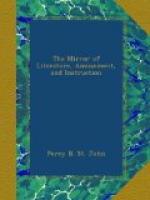The whole song of the Black-throated Bunting consists of five, or rather two, notes; the first repeated twice and very slowly, the third thrice and rapidly, resembling chip, chip, che-che-che; of which ditty he is by no means parsimonious, but will continue it for hours successively. His manners are much like those of the European yellow-hammer, sitting, while he sings, on palings and low bushes.
The song of the Rice Bird is highly musical. Mounting and hovering on the wing, at a small height above the ground, he chants out a jingling melody of varied notes, as if half a dozen birds were singing together. Some idea may be formed of it, by striking the high keys of a piano-forte singly and quickly, making as many contrasts as possible, of high and low notes. Many of the tones are delightful, but the ear can with difficulty separate them. The general effect of the whole is good; and when ten or twelve are singing on the same tree, the concert is singularly pleasing.
The Red-eyed Flycatcher has a loud, lively, and energetic song, which is continued sometimes for an hour without intermission. The notes are, in short emphatic bars of two, three, or four syllables. On listening to this bird, in his full ardour of song, it requires but little imagination to fancy you hear the words “Tom Kelly! whip! Tom Kelly!’” very distinctly; and hence Tom Kelly is the name given to the bird in the West Indies.
The Crested Titmouse possesses a remarkable variety in the tones of its voice, at one time not louder than the squeaking of a mouse, and in a moment after whistling aloud and clearly, as if calling a dog, and continuing this dog-call through the woods for half an hour at a time.
The Red-breasted Blue Bird has a soft, agreeable, and often repeated warble, uttered with opening and quivering wings. In his courtship he uses the tenderest expressions, and caresses his mate by sitting close by her, and singing his most endearing warblings. If a rival appears, he attacks him with fury, and having driven him away, returns to pour out a song of triumph. In autumn his song changes to a simple plaintive note, which is heard in open weather all winter, though in severe weather the bird is never to be seen.—Mag. Nat. Hist.
* * * * *
THE JOHN DORY.
In the 312th Number of the Mirror, several solutions are given of the name of a well-known and high-priced fish, the John Dory, or Jaune Doree. Sir Joseph Banks’s observation, that it should be spelled and acknowledged “adoree,” because it is the most valuable (or worshipful) of fish, as requiring no sauce, is equally absurd and unwarranted; for so far from its being incapable of improvement from such adjuncts, its relish is materially augmented by any one of the three most usual side tureens. The dory attains its fullest growth in




